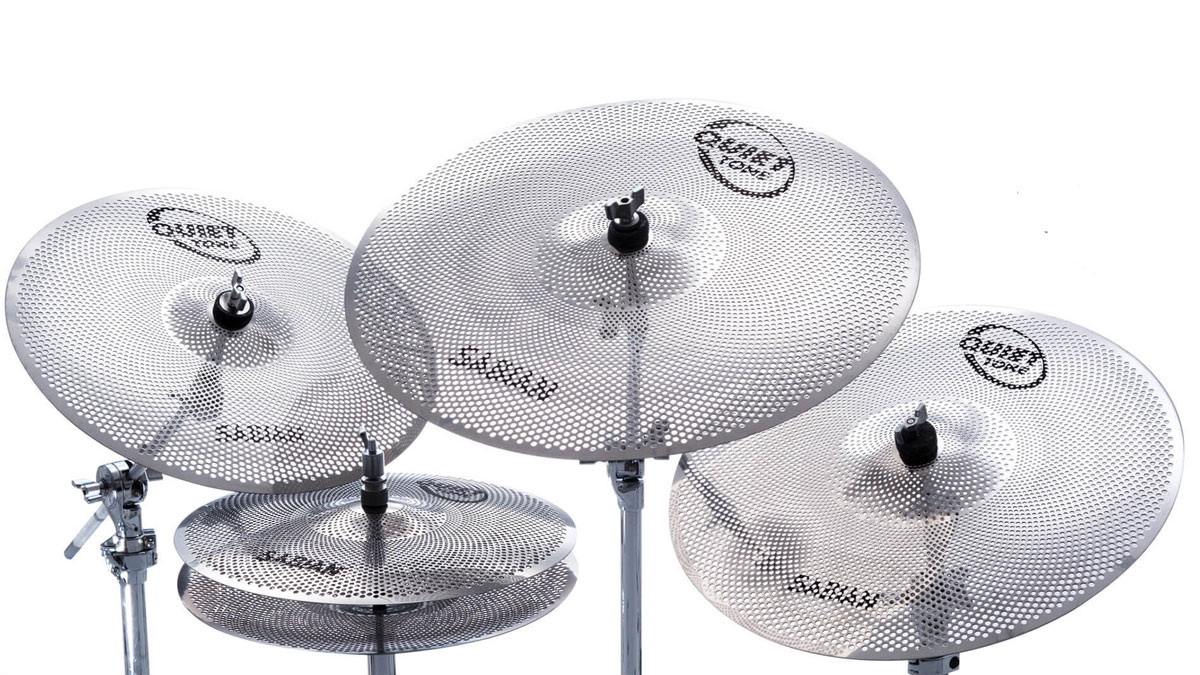MusicRadar Verdict
The concept might not be brand new, but Sabian’s Quiet Tone cymbals are a solid addition to the market for teachers, students and noise-wary practice.
Pros
- +
A great concept.
Cons
- -
Not cheap.
MusicRadar's got your back
We’ve seen a number of solutions in recent times to help combat our greatest nemesis: noise.
From mesh heads to isolation products, it’s clear that things are moving on from the rubber mutes of yore to provide a more realistic and actually enjoyable solution for keeping our kits quiet. The latest development when it comes to our metals are low volume cymbals, and Sabian’s Quiet Tone range is the latest to join the market.
Build
What exactly is a practice cymbal, then? Well, it used to be a cymbal-shaped object made of plastic or rubber that either went ‘clack’ or ‘thud’ respectively, was unforgiving on your hands and depending on its weight and fitting either moved or didn’t. Thankfully, Zildjian’s L80 series - a spin-off from its Gen16 electronic cymbals - gave birth to a new idea. By drilling hundreds of tiny holes in the surface of the cymbal, the volume is reduced significantly, while continuing to maintain the feel and physical balance of normal cymbals.
We saw Sabian’s FRX series earlier this year, which the company is keen to point out are not simply low volume cymbals, and that’s because the Quiet Tone is Sabian’s take on the concept. The Quiet Tones are available to buy in four different sets, and at the moment can’t be purchased individually.
The most comprehensive is our review set - 14" hi-hats, 16" crash, 18" crash and a 20" ride. There are two three-piece setups: one the same as ours without the 18" crash, and a smaller set comprising 13" hi-hats, a 14" crash and an 18" crash ride. The entry-level set consists of the same 13" hats and the 18" crash ride.
Hands on
Sabian has remained tight-lipped on the actual make-up of the alloy it has used here, but it closely resembles stainless steel, forgoing any attempt to colour it like bronze, it promises to be, “tough, durable and resistant to breaking or denting”. With the whole set on our stands, it gives our kit a very different look. The idea is essentially the same as what we’ve seen before: hundreds of holes perforating the bow and bell of the cymbals. Your first notes are met by a couple of things. First is a strong stick attack that allows you to hear and feel every note, and the second is how strange it is to be able to lay into a cymbal slightly without it erupting with wash.
Tonally, these are quite bright, but the sound levels do remain controlled. The hi-hats have a definite sizzle to them, and remain balanced when jumping between open/closed and barks. That stick attack also means that Copeland-style diddles have rarely felt so satisfying to play. The crashes are similar tonally in that they give off a bright chime with a bit of washy sizzle at the peak of the crash. The feel is extremely realistic, with plenty of swing under the stick, however, we did feel that the edges of the crashes were slightly less forgiving than a standard cymbal. This could be in part down to the lack of explosion our ears are used to hearing. The reduced volume is certainly noticeable from the off, to the point where we could notice the vibration noise transferring through our stands.
Finally, there’s the ride cymbal, which unlike mutes or pads incorporates a proper bell. Once again, the controlled nature of the sticking means that we can hear every note we’re playing, and it feels right too. The bell is quiet too, but catching it with the sweet spot of the stick on a hard strike reveals that it’s still capable of creating enough noise to be heard throughout the house.
If you’ve ever spent time playing loud cymbals in a small room, you’ll know just how fatiguing it can be. The Quiet Tones definitely relieve this considerably, taking things down to a manageable level that will be great for teaching as well as practicing where noise is a concern.
Obviously, cymbals are only part of the problem, and if it’s people outside of the room you’re trying to appease, you’ll want to tackle the bass drum and snare noise too. That means that making your kit quiet with a full complement of Quiet Tones Remo Silent Stroke/R-Tom Black Holes or similar is going to become expensive. That said, these are well made, priced in line with the competition and deliver on their promise of ‘real feel’ and vastly reduced noise. We’d take that over rubber pads any day.

I'm a freelance member of the MusicRadar team, specialising in drum news, interviews and reviews. I formerly edited Rhythm and Total Guitar here in the UK and have been playing drums for more than 25 years (my arms are very tired). When I'm not working on the site, I can be found on my electronic kit at home, or gigging and depping in function bands and the odd original project.
With its latest free update, Ableton has finally turned Note into the app I always wanted it to be
Technically capable, but struggle to make your tunes sound musical? 5 simple music theory hacks to make your tracks stand out
"Despite its size, it delivers impressive audio quality and premium functions as well as featuring a good selection of inspired sounds": Roland GO:Piano 88PX review










